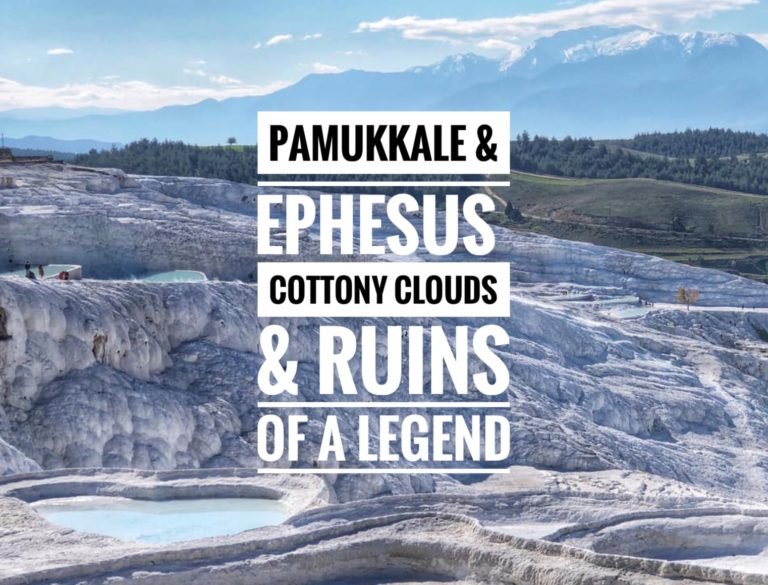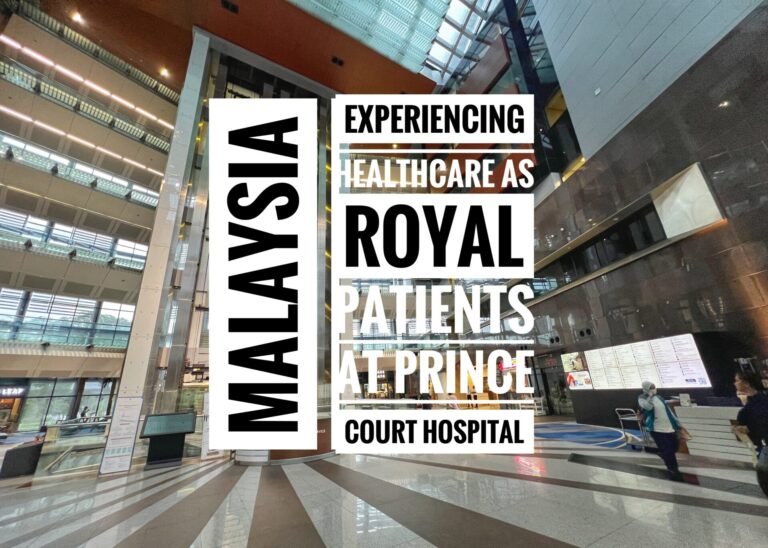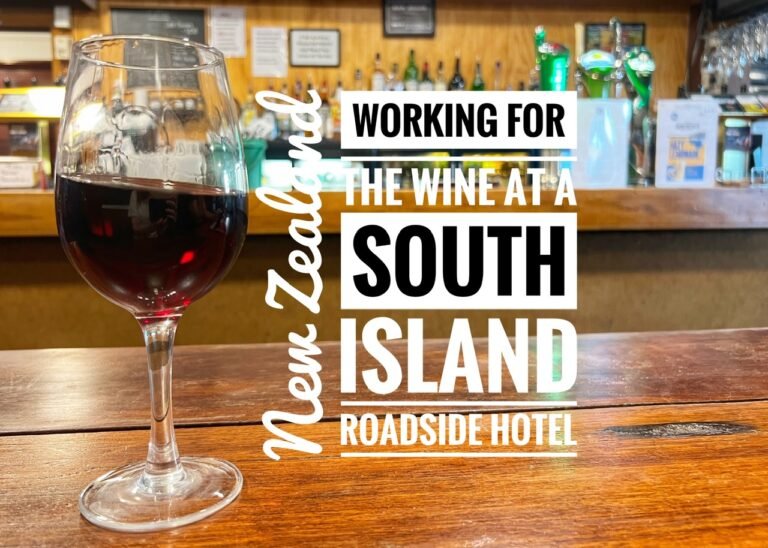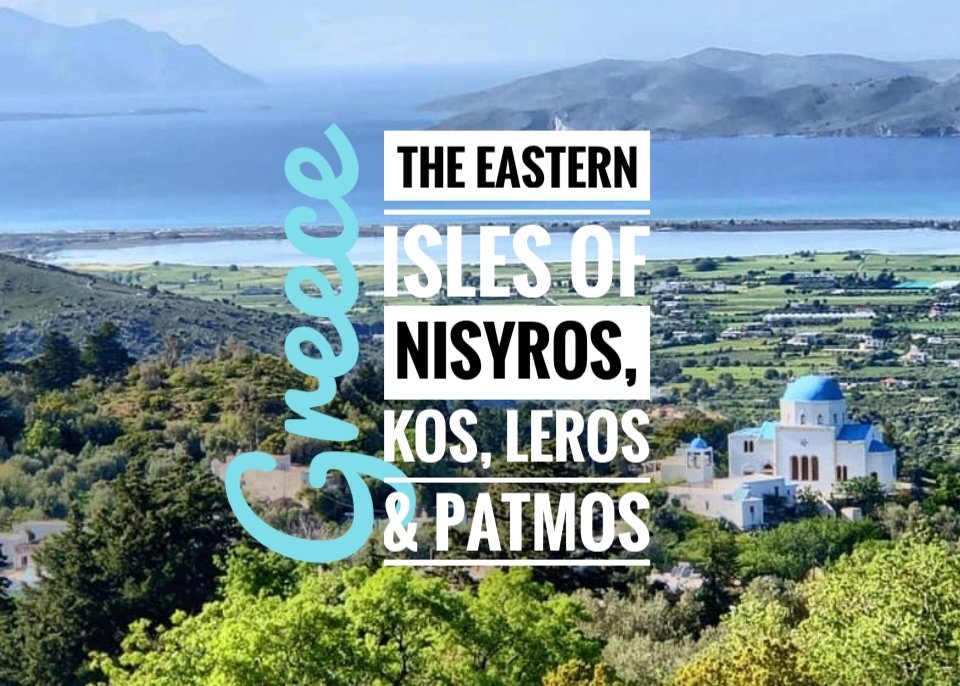
The Greek Islands were not an intended stop on our world tour; they weren’t even on our radar since they are not known to be “budget travel” or even budget friendly destinations. We assumed there was no way to fit them into our $50/day “business model”… That is, until we discovered a HelpX opportunity that traded some manual labor in exchange for free accommodation on the Greek Island of Leros. An opportunity that put the Greece Islands easily within reach to visit. But, to get to Leros (part of the eastern most island chain of the Dodecanese, very near Turkey) we first had to do a bit of island hopping… to Nisyros and Kos.
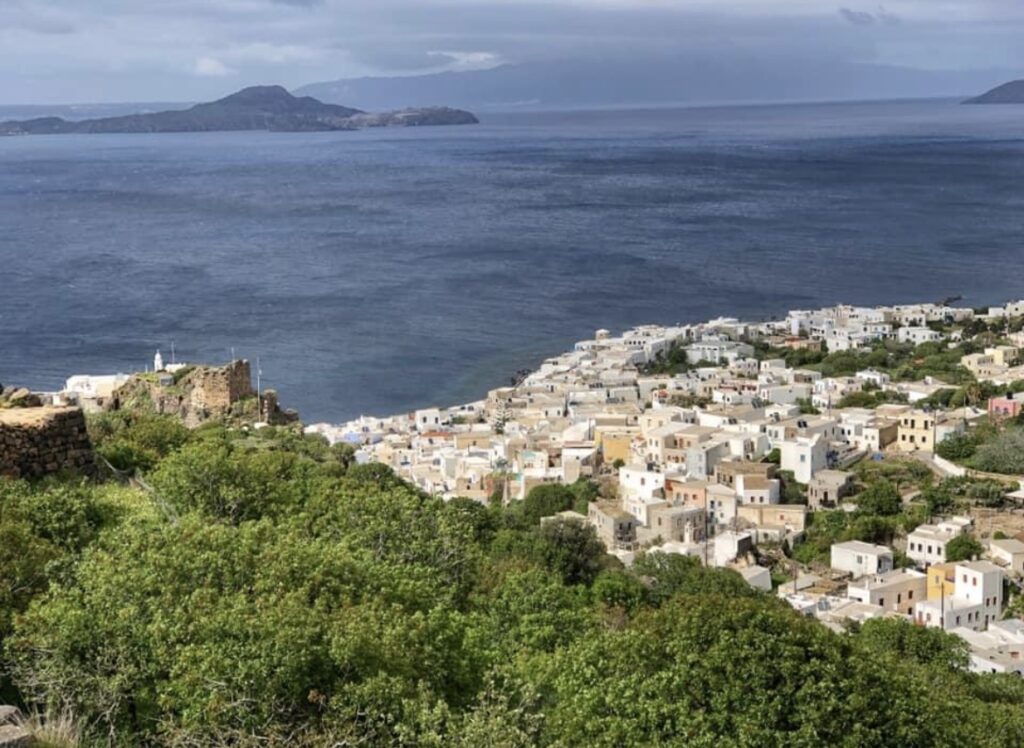
Nisyros
First stop, Nisyros. It’s a Greek Island not on most tourists’ radar, which is exactly why we picked it. As the tourism influx is quite small you have a good chance to experience a more authentic off-the-beaten-path Greek charm there. At just 8k-wide it is a small island, it is also the only Greek Island to have a once active, now dormant, stratovolcano at its core. In fact, the whole island is the volcano. This photo is of the “big city” of Mandraki, 1008 inhabitants.

To get to Nisyros we left from Athens on an 11-hour ferry ride. Those who are following our journey might remember we were last in Turkey before Greece. Well, if the Dodecanese are near Turkey, why would you depart from Athens and not Turkey you might ask? Funnily enough, although Nisyros is less than 20 kilometers from mainland Turkey; because of the time of year there were no ferries we could take to get us there, or anywhere nearby. It was also cheaper to fly to Athens ($78/two tickets and 90 min.) So, Athens it was. Once there we hopped a Blue Star Ferry with our 20€ super economy ticket to Nisyros. Our super cheapo tickets (which we had bought 6 weeks earlier) meant we had no cabin and would have to find some place to sleep in the common areas of the ship. For that price, we’d gladly suffer through it. It was a surprisingly nice ferry however…with carpeted floors, restaurants, bars, and lounges, and…staff in little bow ties that politely smiled at “backpackers” (like us) and welcomed us aboard. Just don’t put your bags on the furniture! After splurging on a 5€ beer and kicking back for a bit, we decided to take our luggage and seek out our sleeping arrangements in the tucked away “air chairs” section of deck 7. Of course these Lazy-Boy recliner seats came with an exorbitant amount of legroom which were unlike any airplane seats we’ve ever been in. Still, despite our stylish eye masks and solid effort, we did not sleep a wink. Then, before we knew it came the announcement at the cheerful hour of 4:10 am to disembark at Nisyros.

In the wee hours of our arrival on Nisyros we were greeted with wind…rain…and coooold, all of which made us wonder if we were actually not in the Greek Isles, but rather we had somehow mistakenly gotten on a ferry to England. Not exactly what we were expecting for a spring April day on Nisyros. As we later found out, this spring is not only unusual, but it had been the wettest on record for many in the Dodecanese. After spending last summer baking in the Ukraine, and seeing snow fall in the Jordanian desert in March our wild weather in Greece is just more proof for us that weather patterns are becoming increasingly erratic due to climate change.
After spending our first two days hunkered down in our Airbnb, we finally got a break from the deluge and were able to get out and do a short hike. Trying to make it to the caldera of the volcano, we weren’t exactly successful, but we did begin to see some of the charm of the Greek countryside between rain showers including many miniaturized (about the size of an ostentatious mailbox in the US) church replicas dotting the roadside which seemed to pay tribute to a particular person, or saint.

On the short day hike (an 8k failed attempt to get to the caldera.) We didn’t get to our destination but we did still manage to get a great workout on this very mountainous island!

When we weren’t hiking during the rain breaks, we were generally inside our two-story house ($22/night) and making this face.

The beautiful church of Nisyros built high into the rock cliff. 98% of Greeks are currently Greek Orthodox. This has changed often throughout history with the ancient Greeks obviously devoted to a polytheistic set of gods, and later on before the government mandated “population exchange” in the early 1900’s with Turkey and WWII, it was mixed with a much greater population of Muslims and Jews.

Another exquisite church built into the cliff face of Nisyros.
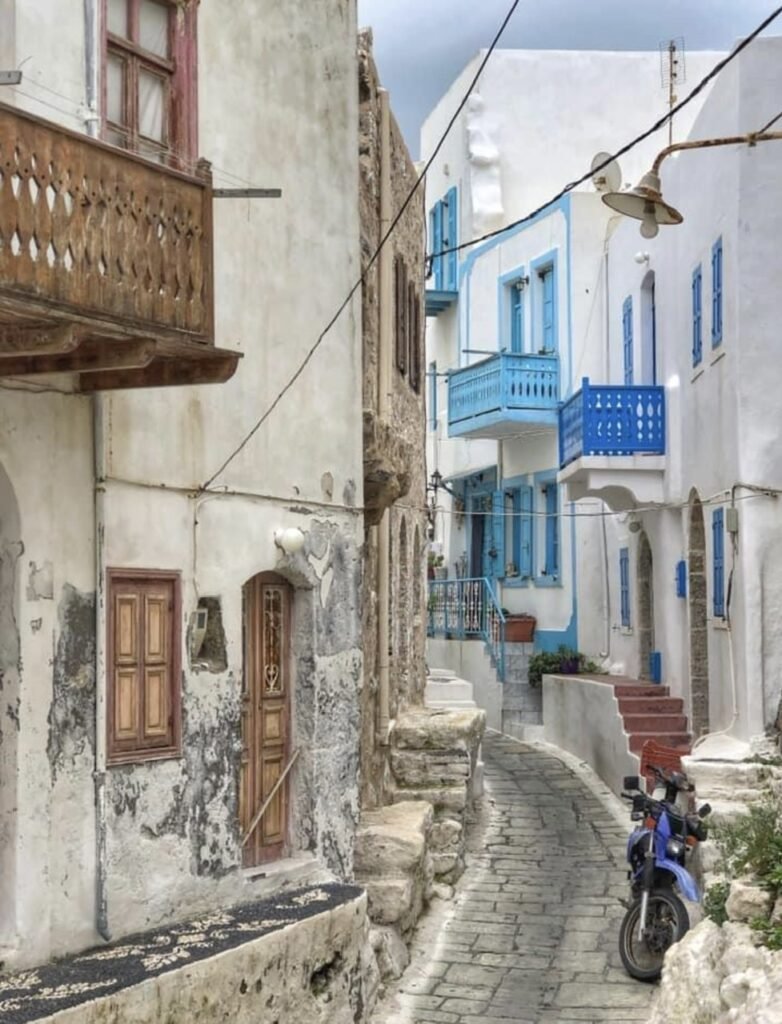
Strolling the pedestrian only streets of Mandraki.

You can’t help love the special character of this place. Even in the sideways rain ☔️

Views of Mandraki/Nisyros. We were practically the only tourists around and because of this, many restaurants and markets remained closed for the season. However, the locals were very inviting. And so were the plethora of feline friends.

On the third and last day, we finally got a decent forecast (aka no rain!) with just clouds and wind. So we decided to take advantage and rent a motorbike (15€ for the day) to putter around the island, which we’d been forced to mostly neglect thus far. We stopped for this view into the caldera, and to warm-up our hands and faces… which felt frost-bitten.

Arriving to the highest point on the island to the uber quaint village of Nikia, which literally teeters on the edge of the volcano. We couldn’t help but wonder can’t why the village founders chose to locate Nikia so high up the side of the volcano and so near to the edge of the caldera. It’s as dramatic a setting as you can imagine. Then in case you forgot you were at the edge of a volcano the wind shifts direction your nose picks up a whiff of sulfur emanating from the caldera below. This village is one of the most iconic spots in the Dodecanese, but shortly after we arrived we were literally standing among the clouds… visibility was about 20 ft. Many people come simply for this adorable and picturesque town square.

Because we love the smell of sulfur dioxide in the morning we went to take in a more intimate whiff. The caldera still belches abundant amounts of sulphur. Driving up to it, which was “only” formed in the last 150,000 years, we witnessed still steaming fumaroles which you can easily take a walk among. The quick trail down inside to the center of the caldera. Of course there is nothing stopping you from exploring the stability of the crust of the caldera too…if you are seeking a Darwin Award.

Arriving to the next village Emporeios. A town that feels completely untouched by tourism that has managed to maintain its traditional and authentic charm. We felt so cut off from the world up here…we loved it!

The desolate yet charming “streets” of Emporeios.

The view down the lush green valley toward the caldera.

Traditional white-washed houses dot the village at every adorable turn.

And the quintessential Greek white-washed churches. (Mandy’s second time sitting on a church roof! Her first time was in Nicaragua!)

Nature provides!! Just in time to warm our chilled bones… of all things, there is an amazing natural (free!) steam room on the road that dead ends at Emporeios. The volcanic activity doesn’t just produce sulfur, but also steam vents which vigorously pump out 50C steam into a tiny man made rock cave at the base of the town. We had no doubt the locals have been using this steam cave for a very very long time. Oh, it felt so good! And, we wanted to stay in the warm steam longer, but we ended up reluctantly retreating when our clothes got damp after just a few minutes. Without swimsuits we just could risk getting soaked for our drive back down in the cold air. If we had stayed in Emporeios, this would have been a major perk!

In the adorable fishing village, or Paloi, we were greeted with a welcome sight!

The abundance of cheap, fresh, and healthy ingredients is one of the best things about being in Greece. Some of the many Mediterranean meals we made included Tabouleh (side of hummus), roasted vegetables, and of course Greek Salad. Also pictured is a typical Greek picnic lunch we’d thrown together that included canned sardines or mackerel, olives, stuffed grape leaves, and dates.

Kos
The next evening we left Nisyros and took a one hour ferry ride to the island of Kos. Kos, unlike Nisyros, is definitely on the tourist trail. Stepping off the ferry, we were greeted in Kos Town with lots of activity and more modern infrastructure. Since it was 9 pm (and as had been the norm…raining) when we arrived, we stayed in Kos Town since the public bus only runs twice per day to the more off-the-beaten-path parts of the island. We had the next morning to explore Kos Town before our departure. Some of the ruins include this mosque tower called Eski Cami. Although the mosque itself has been destroyed, this is a 400-year-old reminder of the Ottoman Empire that ruled over this part of Greece for close to 500 years.

A few other ruins are sprinkled around Kos Town. It seems most of them are unfortunately inaccessible and gated off. We didn’t know if this was the norm, or was a result of the 2017 earthquake that rocked western Turkey and the eastern Dodecanese islands.

We noticed much of the repairs from this 6.7 magnitude earthquake have still not been addressed.

Also sadly damaged in the earthquake was the Plane Tree of Hippocrates. Supposedly, it was under this 2500-year-old tree (?), that Hippocrates, aka “the Father of Western Medicine” taught his students. Hippocrates was born on Kos and is who the Hippocratic Oath was named after. This oath was historically taken by physicians and in its original form, required a new doctor to swear by a number of healing gods to uphold specific ethical standards. It is the foundation of several principles of medical ethics today.

Wandering the streets of Kos Town.

We took a local bus to the south-central Kos Island town of Kardamaina, which served as a central point for us to move about the island. We rented a small studio ($32/night) and were able to walk along one of the many beaches Kos is known for. It was sad to see that many of the beaches here were littered with trash, illegal dumps, and construction materials.

From Kardamaina, we took a 6k round-trip hike to the nearby Antimachia Castle, a leftover fortress from the Middle Ages. On our walk up to the castle we stumbled upon a path. Based on the unkempt state of their beaches and town, the elaborately (overly) constructed and oddly un-signed path to this castle seemed to be a ridiculous waste of money and resources, when clearly most people were driving here anyways. The cost to get in (free) was well worth the beautiful views over to Turkey on clear days.

These little boats that bob in the harbors are a lovely piece of Greece.

On a different day, we hired a car to explore the island at our own pace which was a very good call. Because it was off-season we paid 18€ rather than 39€. Our first stop was Plakka Forest, a beautifully rare Pine forested sanctuary and a babbling brook, a pleasant cross breeze and plentiful peacocks. We even saw baby peachicks, which was a first for us!

Also in the forest are more friendly kitties than you can count. Like Turkey, Greece seems to take care of their feline friends and after tossing some coins in the feeding fund, we were pleased to witness a jolly cat man appear with a bucket of kitty delicacies. What a show watching these cute vultures swarm all around him!

Heading west, it was time to check out the famous Kos beaches, including Agios Stefano Beach which is an eye-catching blend of beach meets ruins. There is an island you can swim to from the beach which features a quintessential little Greek church. Sadly for us, swimming had to wait. Way too cold still! If only the water was warmer!

On the far western tip of Kos is Agios Theologos Beach (which shows you the dichotomy present on Kos.) It’s hard to believe the opposite end is over built with tourist tat.

Oh, at last… that hypnotic water!!

Stopping for a picnic at HUGE Limionas Beach. If only it were warmer… we’d be here all day!

The northern town of Mastichari caught our eye as it seemed authentically Greek and well worth a stopover. Also, it had alluring sandy beaches.

It was then time to head into the central mountainous bits of the island. We were delighted to find this view in the adorable “mountain” village of Zia.

We settled in for a glass of wine at this cozy cafe in Zia. The decor, vibe and view couldn’t have been more perfect.

And lastly, to end our day we had heard that there were was some (free!) hot springs on the beach on the southern part of Kos. It’s called Therma Beach on the map, and a local had given us some vague directions to get there… adding only that we will need a shovel to dig out a hot pool to sit in. Very intrigued, (and shovel-less) we were determined to bag these hot springs. Therma Beach turned out to be something really unique and one of our highlights to visiting Kos. It is a raw experience, it’s a totally undeveloped hot spring and thermal area, and the setting is absolutely fantastic. It’s not for everyone… you have to be into natural hot springs and you have to be willing to put some work into creating your hot spring pool to wallow in. When you arrive to the thermal sands, right at the edge of where the waves brake on the shore line, you dig your own hole (or pot) in the sand. (Using a stick…no shovel was conveniently provided)? The deeper you go the hotter the water gets once you’ve carved out your hot pot to unveil hot steaming thermal water just below the surface of the beach. When you plop down into the water the reward for your efforts is paid back…big time. You are literally at the waters’ edge, waves crashing at your feet, looking out into The Mediterranean on a black sand beach and you are toasty warm. It also makes a great opportunity to work up the courage to do a polar plunge!

Leros
From Kos island, we island hopped northward to the Greek island of Leros for a two week stay for our first HelpX experience. HelpX works as a sort of exchange to connect those who have labor or volunteering (us in this case) in exchange for accommodation (and in some cases board) from a host. Our HelpX included accommodation on a “1938 vintage yacht.” Leros and Patmos are both part of the Dodecanese (dodeca=12 islands) island chain which borders Turkey.
Leros, which has been inhabited since 3rd Century BC, is an island which seems relatively authentic and unspoiled by the modern world, at least in April. The town we stayed in, Lakki, didn’t necessarily ooze the traditional Greek charm that we’d seen on Nisyros or Patmos, however. It’s not as historic, but it did have a unique architecturally modern style that we couldn’t quite place. Apparently the Italian occupation is the answer, which lasted from 1912 through 1943, is to blame for this. Mussolini highlighted Leros, and particularly Lakki, as a base of utmost importance for the Italian navy and dominance in the area, because of its strategic geographical position, and because it had the largest natural harbor in the Eastern side of the Mediterranean Sea. (Leros.gr) Nature, is the sparkling diamond of this very walkable island, which was luckily for us, totally saturated in a springtime blanket of wildflowers.

Our boat “Tricia” was a fish out of water. She was dry-docked in the Lakki marina. Our HelpX hosts were a kind couple, a retired Royal Navy Captain from the UK and a sailboat skipper from the States. Prior to settling into their home on land, they told us they lived on Tricia for 10 years; traveling all over the Mediterranean and the Red Sea. Tricia has indeed gotten around!! Most afternoons you could find us lounging on our favorite part of the boat, the stern; enjoying a happy hour (or two) with Greek table wine, Greek mezes prepared in our kitchen or simply out of a tin, and complimentary sunsets.

A view from one of the many walks on the island. Pictured in the distance is the island of Kalymnos.

Living in a boatyard on a (dry-docked) boat for two weeks was a singularly unique experience. We got more than a passing glimpse into a subculture that we always knew existed but never really knew how to define it. Well, We got to meet all kinds of characters who were either part-time or full time boat dwellers in the marina, from Italians to Brits to Germans, mostly 60+ in age and most retired.
Also, from our perch we enriched our picture of this alternate lifestyle in:
1. observation of the incredible way in how boats are hoisted to and fro from the water using gigantic motorized slings on wheels and maneuvered around (picture 1)
2. frequent chuckles at boat names like Valium and Zanax (picture 2),
3. A preference for the darling little dingys (picture 3)
4. Finding “the free stuff area” where daily deposits were made from boat owners of no longer needed items like piles of paperback books…IN ENGLISH, or clothing, or ??? When you’ve been reading a kindle for 9 months, this is a VERY exciting find!
5. watching the adorable old guys constantly buzzing around the boatyard on their collapsible bikes going, back and forth from their boats to the common bathrooms (which btw had amazing hot water pressure).
6. Finding new ways to curse at Mother Nature during an incessant five day and night long(!) 30 mph windstorm with winds that hammered our boat and produced clanging, whirring and whistling noises in the boatyard and in our ears that drove us to the edge of sanity.
7. hand washing our clothes in the sinks (along with literally everyone else) because the marina charged an exorbitant 8€ ($9.60) for a wash.
8. some unsettling boat quaking, not the wind this time, but dynamite! Good Friday is apparently reason enough for the locals to begin setting off frequent and large dynamite charges. IN TOWN! Leros is also home to a sizable population of refugees that Greece has taken in from Syria and other conflict laden countries… We worried that these large explosions were traumatic and stressful for these survivors of war zones. The explosions certainly unsettled us! (more on that shortly.)

On the east side of Leros is one of the cutest, most picturesque fishing villages we saw in Greece, Panteli Beach, tucked under the town of Platanos.

For some unique accommodation there is even an opportunity to stay overnight in one of the historic traditional windmills above the beach. The windmills were once used to grind grain and many of them can be found sitting stationary throughout the Greek islands. However, in the case of Leros, the windmills were conserved and in many cases, they have been restored. Several of them have now been turned into guesthouses ($60+). We gazed longingly at them, but settled for a cheaper option for our “getaway” from Tricia to explore another part of Leros.

For a night, we stayed at Paradisso Studios near Panteli Beach ($31). The view was magnificent

The historic windmills on the way to the castle offer a panoramic view of the island.

Poppies are everywhere on the islands. Mandy overlooks Panteli Harbor.

It’s been a long day!

The castle of Leros, also called the castle of Panteliou, dominates the eastern part of the island. It was built in the 11th century by the Byzantines and was unsuccessfully sieged by the Ottomans in 1505 and 1508. The whole island was later captured by them in 1522 which held until the Italians began occupying it in the Italian-Turkish War.

Little churches, on the hillside. Little churches on the beach. Little churches everywhere!

The port of Agia Marina. This is where our ferry arrived and departed the island.

Fisherman have been catching, drying and dining on octopus for millennia in Greece. To eat them they have to go through quite a process by first cutting their necks, scooping out the entrails and then, in order to make it palatable, they tenderize it by beating it on the shoreline rocks. It is then hung to absorb the sun on a line which soaks up all the water before it is grilled. Octopi may look like little eight-legged aliens, but we still couldn’t bring ourselves to eat them after watching and understanding the process.
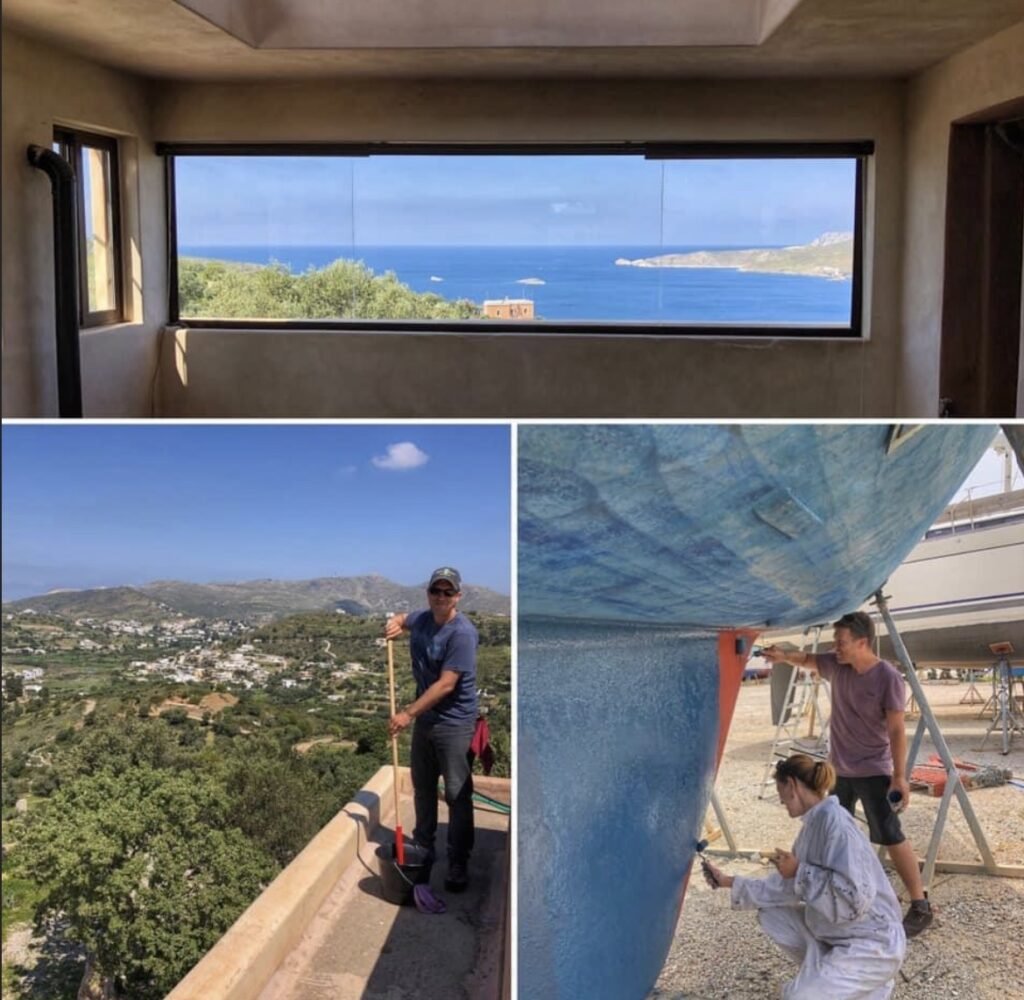
Work hard, play hard! Our tasks for our HelpX hosts included washing windows on Christy and Mike’s beautiful sustainable and self-built home, weeding, digging out and grading a trail to their home, and some sailboat maintenance.

Patmos
Arriving two weeks later to the island of Patmos, also know as the Holy Island, also the Island of Revelations, and also the Island of the Apocalypse (cheery, we know!) Our room at Romantza Hotel ($39/night) had a lovely balcony view of the Skala harbor and surrounding mountains and our hosts were absolutely incredible. They treated us like honored guests! In addition to picking us up at port, we were greeted with homemade apricot cobbler, and a fridge stocked with juice and water. Wow!

Later in the day, they also brought us Easter bread (Tsoureki) and Greek Easter eggs. The eggs are hard boiled, dyed red to represent the blood of Christ, and the hard shell represents the sealed tomb of Christ. The cracking represents the resurrection. We’ll never eat a hard boiled egg the same again! The chocolate bunnies and marshmallow peeps are strangely missing from this elaborate tradition.

Another little Greek church. Every one of these churches was packed with often standing people the eve of Holy Saturday. It’s hard not to stumble upon a church at every turn here. Patmos has more churches than any other Greek island.

Walking through the streets of the main port town where we stayed, Skala.


A hushed moment during the day before the chaos of Holy Saturday began. This is the church we returned to later that night.

Although Greg and Mandy are usually the 10pm-in-bed types, we’re early birds(!), we were encouraged by some Greek friends not to miss the rising of Christ celebration, which BEGAN at 11 pm on Holy Saturday evening.
Crowds began to gather in churches at 11, and further spilled outside as time got closer to midnight, along with the priests. It was an extraordinary spectacle to hear the incomprehensible but still entrancing Greek Orthodox hymns envelopes us. It was peaceful and reverent… until being abruptly snapped out of our moment fittingly uttering “sweet Jesus” or a worse expletive after dynamite explodes mere feet away. Seriously, the casual use of dynamite and blasting caps for Easter celebrations in the Greek islands, is deeply troubling to the uninitiated. Although whenever we mentioned our concern for safety and our discomfort to the locals their reply was basically “be glad you’re not on Kalymnos… they’re crazy with dynamite!” where they toss it off cliffs into the towns below, with seemingly no regard for public or personal safety… many people get injured every year. We read many reasons why fireworks and dynamite has been associated to Easter in this part of Greece. The wildest being that it is to recreate the effect of the earthquake at the time of Resurrection. Although no political agenda is set forth, the most believable reasoning is that the affinity for dynamite in the far eastern Dodecanese islands is to remind their Turkish (Muslim) neighbors of the Greek Orthodoxy and the resurrection in a place where there still may be outstanding territorial tensions. Regardless of their reasons, the vibrations of the events leading up to Easter go on for days inside your body and we didn’t really walk away feeling much peace of Christ.

A beautiful young girl at the Christos Anesti.
Go Jesus Go!! Happy Easter!!

After the ceremony, everyone loosely (this is Greece after all?) forms a candlelight procession and heads into the dynamite-infused streets toward their favorite restaurants where the tables are set and bedecked for their midnight feasts to break their fasts. We chuckled at ourselves remembering the last time we ate a big meal at midnight (drunk in college?) and headed home for our earplugs, dodging dynamite the whole way.

Lamb on a spit (souvla) is the official Easter meal, representing Jesus as the sacrificial lamb. It is eaten as the midnight feast or later in the day on Easter. Another reason we didn’t partake.

The next day we walked 4K up the hill to the town of Chora, the oldest developed area on Patmos. We spied these sweet ladies on the walk up and couldn’t help capturing them with these electric pink flowers.

Our first stop in Chora was the Cave of the Revelation where it is said that St John the Theologian wrote both his gospel and the Book of Revelations around 95 AD. Unfortunately this UNESCO world heritage site was closed on Easter. So we didn’t get to see any apocalyptic themed cave accolades inside this monastery, though we did spy a ferocious bee hive over the door which could have been equally apocalyptic for Greg who is deadly allergic.

We continued on to the fortress Monastery of St John, built in 1088, and dedicated to this notable disciple. And because it was Easter, there was a lot of activity. Inside we got to witness the several priests using wooden mallets to drum in unison on a hanging wood board (apparently called a tlando) making the most bizarre and ethereal sounds.

Prayer candles being lit and priests buzzing about as we admired the surroundings of this astounding monastery.

The entrance to the Monastery.

Another beguiling white-washed church in Chora

The lovely church bells in St Johns Monastery. We got to witness them clanging at various times throughout the Easter celebration, and undoubtedly they echoed far throughout the land below.

After the Easter festivities in Chora, we walked around the beautiful pedestrian-only village and soaked in one dreamy view after another.


One of the many narrow streetscapes in Chora.

And arriving to the windmills of Patmos, which put the intricate and expert craftsmanship of the builders on full display. Two of them date back to 1588, and the third 1863. They fell into disuse in the 1950’s.

A 360 degree view of the windmills, monastery and surrounding island from the top.

Eating on the beach…with a cat. This is what you do in Greece.

On Easter night, we were lucky to meet up with a Greek friend of a friend, Katerina, who we joined for a traditional Easter festival.
Katerina even managed to drag Mandy onto the dance floor for some traditional song and dance (it wasn’t that hard…they were also giving away free wine!) What a fun authentic evening!

Time to say goodbye to the little dingys…and the islands! To the mainland we come!

